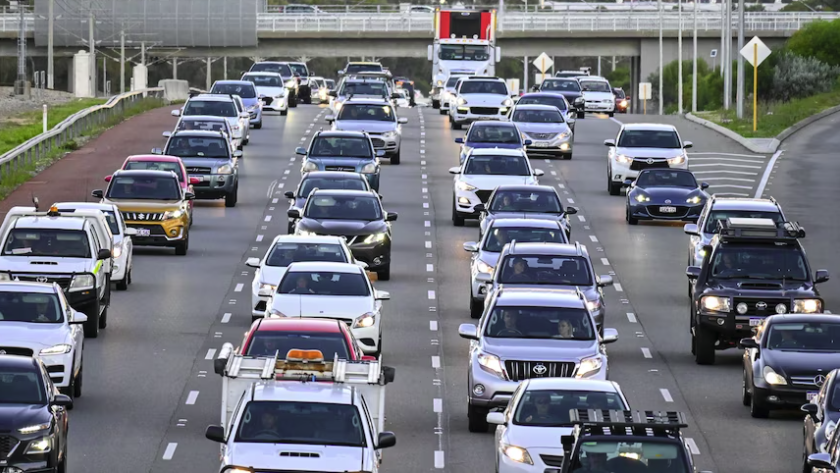Regional cities with transit systems “designed around utes” are destined to die, warns a leading Australian sustainability expert.
Key points:
- The Queensland government has indicated “bus rapid transit” is the preferred option to connect to the direct Sunshine Coast rail line
- The announcement means light rail is no longer being explored
- Experts say it is a step in the right direction for the booming region
Transport experts from Melbourne and Perth say the decision to endorse “bus rapid transport” as the preferred option for the Sunshine Coast, Australia’s ninth-largest city, is a step in the right direction.
The announcement, made by Queensland’s Department of Transport and Main Roads (TMR) as part of the Mass Transit Project, effectively shelves the Sunshine Coast option of light rail infrastructure such as the Gold Coast.
Professor Peter Newman, author of more than 20 books on sustainable cities and a key figure in Perth’s well-patronised rail network, said the Sunshine Coast would thrive with a better-functioning public transport system.
“It’s increasingly the case that if you build more around cars, you drive the economy down,” Professor Newman said.
“You can’t build a city around cars. It just dies.”
Professor Newman said to be a “serious city and not a country town anymore”, public transport was “extremely important”.
“Every city has to go through that transition,” he said.
“That’s what we did in Perth … we’ve now passed Brisbane in terms of the number of people who travel by train which is pretty amazing because we’re a fair bit smaller, have fewer tracks and fewer trains.
“You don’t actually have to design everything based around a ute.”
Despite having a background in rail advocacy, Professor Newman said there was no point constructing a light rail system “when you can have a trackless tram that does exactly the same for a 10th of the price”.
TMR said the bus transit system for the Sunshine Coast could include trackless trams which “operate on rubber wheels and follow line marking on the road surface” and “eliminate community concerns about overhead wires, fixed steel tracks and noise”.
Cheaper in the long run?
Melbourne’s Peter Parker, a former bus network planner with Public Transport Victoria and avid transit blogger, cited Perth, Zurich (Switzerland) and Curitiba (Brazil) as global cities that set good examples with public transport.
However, he said the perceived economic savings of buses or trackless trams, compared to light rail, could sometimes be misleading.
“Whatever you choose, the most important thing is prioritising what has right-of-way,” Mr Parker said.
“Achieving that is the biggest cost, because it might require completely new corridors or reconfigurations of the existing roads.
“At the end of the day, a non-rail solution might not be all that much cheaper.”
Mr Parker said interconnectivity between different transport forms and developing the right “culture” towards public transport would be essential to the Sunshine Coast’s plan.
“You look at a place like Zurich … it has very good planning, frequency and interconnected routes that link up with each other just in time,” Mr Parker said.
“The Gold Coast is doing it well. Brisbane is quite poor. The Sunshine Coast remains to be seen.
“The main thing with building a good cultural attitude towards public transport is reliability and usefulness to grow trust.
“The best cultural change I’ve seen in Australia is what Perth did in the 1990s and a big factor is making trips shorter than they would be by car — service quality is essential.”
Running late
Sunshine Coast transport advocate Jeff Addison said his initial thoughts of the region adopting a ‘bus rapid transit’ solution were that it “wouldn’t have the same capability” and was a “shorter-term solution” than rail.
Mr Addison said the main positive he saw from the proposal was that the Sunshine Coast would “retain its individual identity instead of becoming like the Gold Coast”.
Former Sunshine Coast resident Iziah Esera Catrileo moved to Peregian Beach for work and sport in 2019, but then chose to relocate to Brisbane and then Melbourne, saying his decision was “100 per cent” influenced by public transport.
He said at times it was quicker to travel onward to Brisbane by catching three connecting buses over a 52km distance to Landsborough train station, rather than 30km to his nearest train station in Nambour.
His “final straw” came when he spent almost five hours travelling by public transport to see family in Logan.
Noosaville resident Otavio Dias, a foreign student from Curitiba, Brazil, said the greatest drawback of the current Sunshine Coast bus system was vehicles “not showing up on time, if at all”.
Mr Dias said it was a shame, not only because it caused difficulties for him reaching businesses and services in Maroochydore and further south, but because Noosa needed public transport to alleviate car parking and traffic problems.
